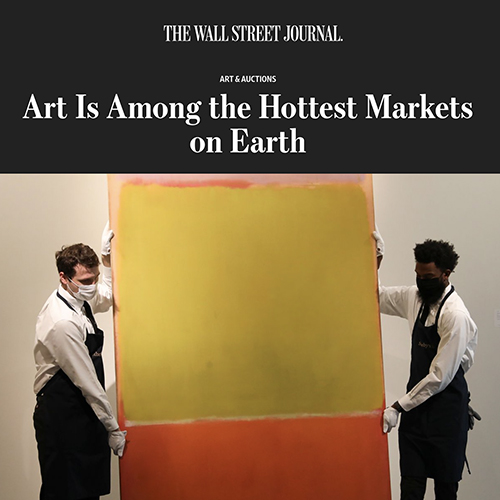Heather James co-founder, Jim Carona, discusses the values of art as an investment. Fine art offers unique advantages, and it is important to note that the performance of blue-chip art shows low correlation to the fluctuations of other asset classes.
“The two greatest stores of wealth internationally today include Contemporary Art…and I don’t mean that as a joke, I mean that as a serious asset class, and the other store of wealth today is apartments in Manhattan, Vancouver, and London.” – Larry Fink (BlackRock)
- Ray Dalio (Bridgewater Associates) picked fine art, gold, and Bitcoin
- Jim Rogers (Quantum Fund/Soros Fund Management) chose silver, copper, agriculture, and fine art
- Jeremy Grantham (Grantham, Mayo, & van Otterloo) noted fine art as an inflation hedge
Advantages of art as an investment
Demand
The global value of art is expected to grow by 53% by 2026
Art market growth: According to UBS, the art market saw $50.1 billion global sales in 2020. 86% of wealth managers recommend offering art services to clients according to Masterworks.
Rise in worldwide wealth: Based on a 2020 report from Credit Suisse, more than 1% of all global adults are millionaires (USD) for the first time in history, with their combined wealth up nearly fourfold in a 20-year period.
30% of millennial collectors have over 30% of their wealth held in art – UBS/Art Basel Report

Museum growth: By the end of 2020, China was home to 5,788 museums, all seeking top-tier artworks for their collections. According to the Economist and ChinaDaily, an average of 1 new museum opened every 2 days across China between 2016 and 2020, and this trend is continuing globally.
More investors collecting: The latest UBS/Art Basel Report indicates that more collectors are using art as an alternative asset: 61% of the HNW collectors surveyed had over 10% of their portfolio invested in art.
Scarcity
There are a finite number of paintings in existence by the most highly sought blue-chip artists. For example, there are only 800 Monet paintings owned privately that could ever come up for sale, and these will make their way into museum collections over time, further limiting supply.
Tangibility/portability
Many HNW individuals in unstable regions prefer to invest in art and other tangible assets to mitigate currency and/or political risk.
Inflation Hedging
- Art performs very well historically as a hedge against inflation.
- Inflation in the U.S. is at a 30-year high.
Return On Investment
Art has historically outperformed the S&P 500, see graphs below for additional comparisons to gold and the housing market over 20-years.
Correlation with Other Asset Classes
The correlation between art and the S&P 500 was just 0.12 during the past 25 years, according to the Citi Global Art Market chart.
“The increase in households’ net worth in 2020 resulted in more than 5 million additional millionaires globally versus 2019 and 24% more individuals whose wealth exceeds US$50 million, according to the Credit Suisse Global Wealth Report 2021. This should feed demand for all kinds of assets, especially stores of value given that investors are concerned about diversification in the face of value erosion through inflation.”
– Dr. Nannette Hechler-Fayd’herbe of Credit Suisse
Heather James Fine Art is not a registered investment, legal or tax advisor. All investment and financial opinions expressed by Heather James Fine Art are opinion based on personal research. Past performance is not a guarantee of future return, nor is it necessarily indicative of future performance.











